| Already a member? Login Now! |
|
 |
|
3 great ways to use Student News Net!
SNN invites you to sign up for a subscription for our award winning site, with access to great stories and educational features. Obviously we are proud of our accomplishments, but we really want to share the truly engaging stories and custom features for the classroom and beyond.
As an ad-free site, SNN relies on subscriptions to enable it to produce this award winning educational website. Where else can you get daily updates of engaging stories and current events backed up by interdisciplinary activities and extra features?
|
|
|
|
|
 |
 Slog: verb – to work diligently for long hours slogged, slogging, slogs Slog: verb – to work diligently for long hours slogged, slogging, slogs
(The American Heritage Dictionary of the English Language, Fifth Edition, ©2014 by Houghton Mifflin Harcourt Publishing Company) |
 |
|
On Nov. 24, 2014, European Space Agency (ESA) engineers and this stellar SLOG with ESA engineers, answered students' questions live from Germany through a SNN SLOG-ITT session. All three scientists will again answer students' questions live from Germany on Wednesday, Oct. 7 at 10 a.m. CT (11 a.m. ET). After studying the content below, submit questions in the Chat and Collaborate box to the right. Join us on Oct. 7 for this stellar SLOG with ESA scientists!
|
| EXTRA! EXTRA! WRITING PRACTICE |
| |
| Practice Your Writing Skills by summarizing what you've learned by reading, sharing and participating in this SLOG. |
 |
|
|
|
In G+
https://plus.google.com/events/cmu397puicsuv2io6roitutvnn4
In YouTube:
http://www.youtube.com/watch?v=irMD2atDXIU |
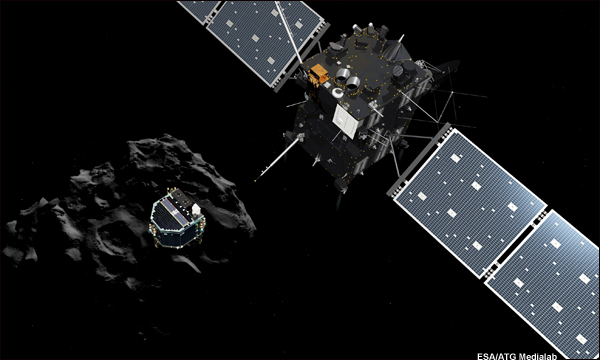 |
Artist drawing of the Philae Lander separating from the Rosetta Orbiter (Photo: ESA/ATG Medialab) |
| SNN SLOG - Rosetta Orbiter & Philae Lander |
Launched on March 2, 2004, the Rosetta Orbiter, with its small Philae Lander spacecraft safely tucked into its side, arrived near Comet 67P on August 6, 2014 after traveling 6.4 billion kilometers in ten years. From its orbit just a couple of hundred kilometers above the comet's surface, Rosetta sent back data so European Space Agency (ESA) scientists could determine where to land Philae. After scientists chose a landing site, it was all systems go on November 12, 2014. The Rosetta Orbiter jettisoned Philae for its landing. Philae bounced before coming to rest on a spot shaded from the sun. After using its battery power for about 60 hours to send data to Earth, Philae went dark and into hibernation when its solar panels could not generate enough power to keep it operational. However, ESA scientists knew the comet was moving closer to the sun and hoped the sun would shine on Philae's panels. Comet 67P’s perihelion – its closest approach to the sun – will occur on Aug. 13, 2015. On June 14, Philae woke up and “spoke” to Earth for 85 seconds. “Philae is doing very well: It has an operating temperature of -35 degrees C and has 24 Watts available,” Dr. Stephan Ulamec, Philae project manager, said in a June 14 press release. "The lander is ready for operations."
SLOG-ITT: Rosetta Mission (European Space Agency, ESA) |
| |
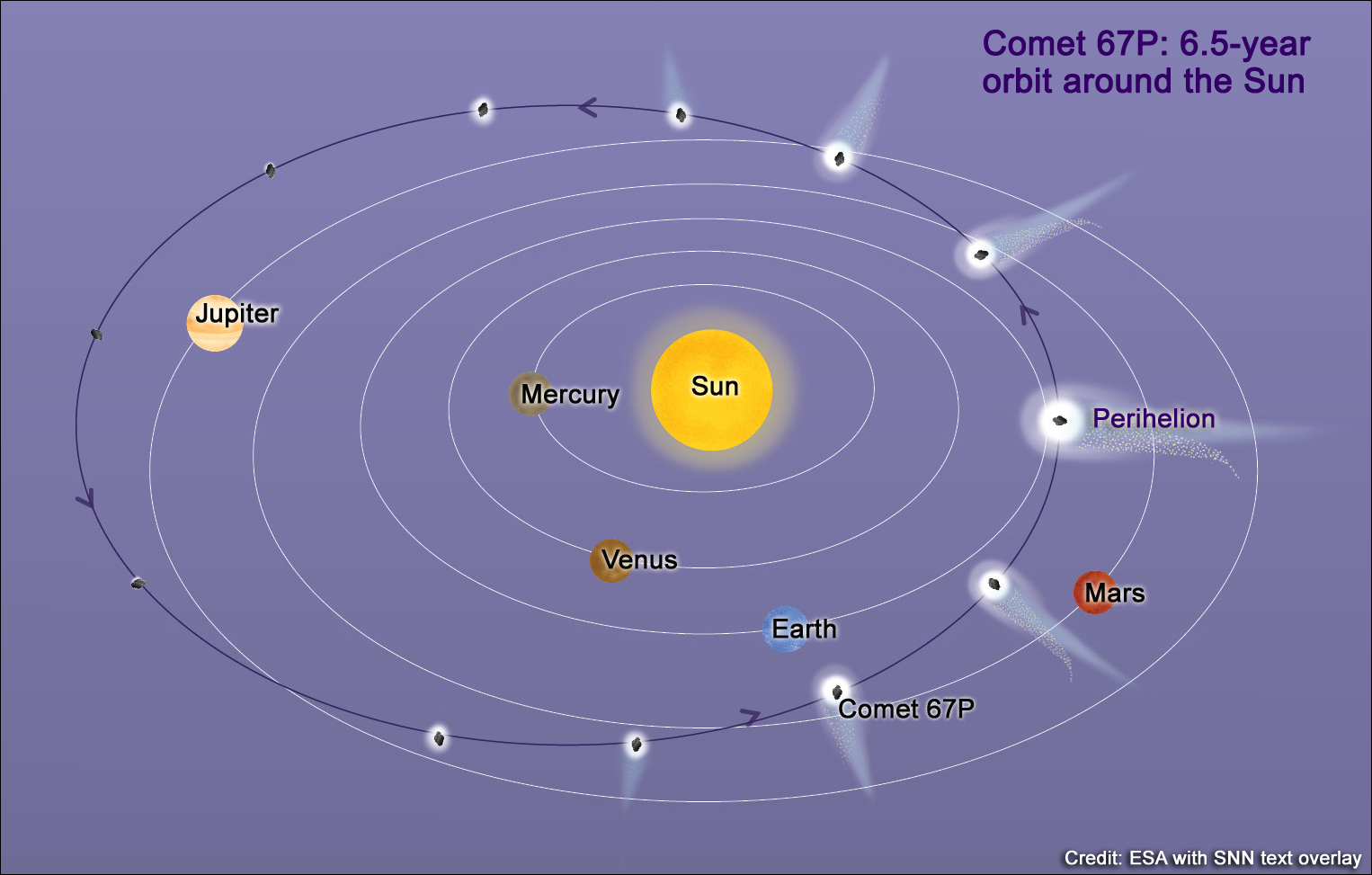 |
| Comet 67P: 6.5-year orbit around Sun (Credit: ESA with SNN text overlays) |
Question 1: Look at the graphic. Where is the aphelion?
Question 2: Why are ESA scientists expecting Philae to have enough solar power to communicate with Earth when the comet is at its perihelion? |
| |
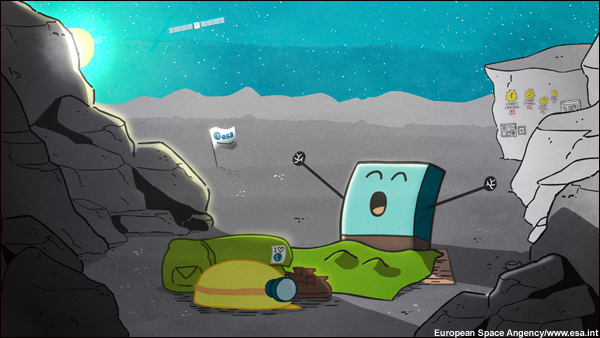 |
Philae wakes up (Graphic: ESA) |
| |
| Comet Chemistry* |
According to ESA, Comet 67P contains the following chemical compounds** and elements as determined by data sent by the Rosetta Orbiter: |
Identified on Comet 67P |
Importance and/or where found on Earth |
Water – H2O |
Compound: essential for all life on Earth |
Carbon monoxide – CO |
Compound: Interferes with respiration so high levels toxic to humans |
Carbon dioxide – CO2 |
Compound: gas exhaled by animals – byproduct of respiration; essential for plants to conduct photosynthesis |
Methane – CH4 |
Compound: hydrocarbon |
Ammonia – NH3 |
Compound: source of nitrogen essential to form proteins |
Methanol – CH3OH |
Compound: an alcohol, also called “wood alcohol” |
Sodium – Na |
Element: one of two atoms in salt (sodium chloride – NaCl) and one of three elements in baking soda (NaCO3) |
Magnesium – Mg |
Element: found naturally in spinach, nuts and whole grains; important for protein synthesis, muscle and nerve function (NIH) |
* Legend for chemical elements |
H = hydrogen
O = oxygen
C = carbon |
N = nitrogen
Na = sodium
Mg = magnesium |
** A chemical compound is a substance made up of two or more chemical elements. |
|
| |
Question 1: What is missing from the list that is fundamental to life on Earth? From this evidence, what conclusion can you make about Comet 67P?
Question 2: Since both CO2 and H2O have been idenitifed on Comet 67P and both are needed for photosynthesis, do you think plants are growing on the comet? Why or why not?
Question 3: What is the difference between a comet and an asteroid? Learn about the two celestial bodies here (NASA). |
| |
| Primary Source References |
Notes & Information from Experts |
- Rosetta Mission
- Rosetta Fact Sheet
- Make your own paper models of the Rosetta Orbiter and the Philae Lander
- What are comets?
- Rosetta Timeline
- Rosetta Blog
|
“ESA and its Rosetta mission partners achieved something extraordinary today,” Jean-Jacques Dordain, ESA’s Director General, said. “Our ambitious Rosetta mission has secured another place in the history books: not only is it the first to rendezvous with and orbit a comet, but it is now also the first to deliver a probe to a comet’s surface.”
Jean-Jacques Dordain, ESA Director General, on Nov. 12, 2014
|
| Technical Vocabulary |
- Comet Nucleus: solid, middle part of a comet; also called a “dirty snowball” – Comet 67P is about 4 kilometers (2 miles) wide; Comet 67P has a loosely packed, porous nucleus, according to ESA
- Comet Coma: atmosphere around comet (gases that have been heated by Sun)
- Perihelion (noun): closest point to the Sun (Comet 67P ~ 185 million kilometers)
- Aphelion (noun): farthest point from the Sun (Comet 67P ~ 850 million kilometers)
- Hibernation (noun): dormant, inactive state
- Comet 67P – also called Comet Churyumov-Gerasimenko after the Russian scientists who found the comet in 1969
- Volatiles (noun): compounds that can easily ignite, burn
- Morphology (noun): the study of shapes, sizes, and structures of both living and nonliving things
- Minearology (noun): the study of minerals
- Dynamic (adj.): changing, not static, active
- Refractories (noun): compounds that refract light
- Jettisoned (verb): separated, propelled away from another craft
- Porous (adj.): not solid, with holes or openings
|
|
| Multimedia |
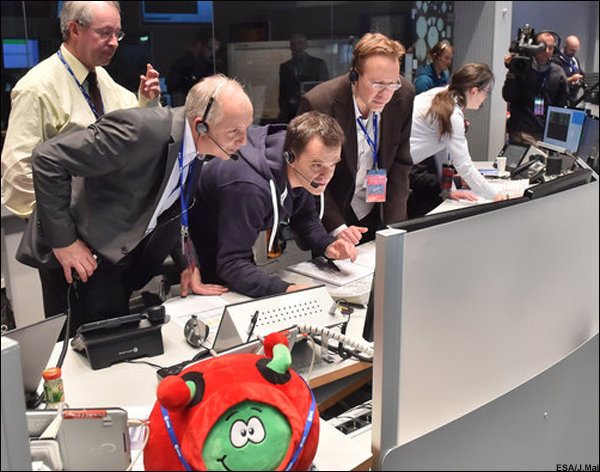 |
|
| ESA scientists receive confirmation that Philae landed on Comet 67P on Nov. 12, 2014. (Photo: ESA/J.Mai) |
Rosetta’s Twelve-Year Journey in Space (Timeline) |
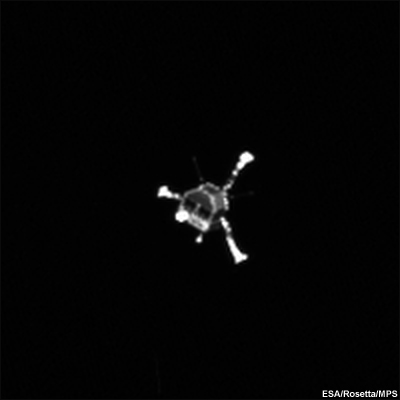 |
Demonstration of Rosetta and the Philae Lander by an ESA astronaut on the International Space Station |
The Philae Lander as it approached Comet 67P for landing on Nov. 12, 2014. (Photo: ESA/Rosetta/Philae/ROLIS/DLR) |
|
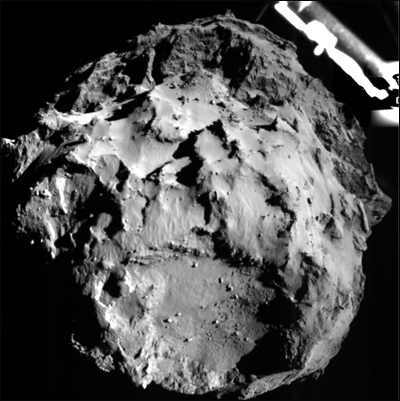 |
ESA: Once Upon A Time: Preparing for Comet Landing |
| Picture taken by the Philae Lander as it approached Comet 67P for landing. Note one of Philae’s landing legs in top right of the photo. (Photo: ESA/Rosetta/MPS for OSIRIS Team MPS/UPD/LAM/IAA/SSO/INTA/UPM/DASP/IDA) |
|
|
|
|
|
|